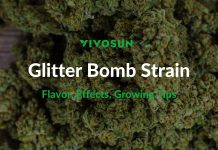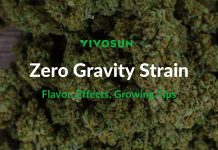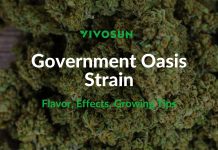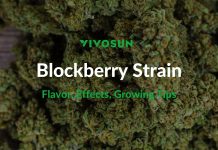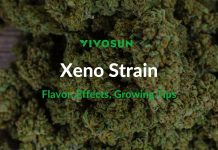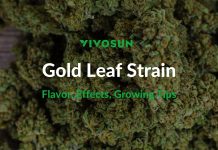Table of Contents
Let’s get detailed about lights: grow lights are the most prominent part of your tent but can be damaging to plants if used incorrectly. A grow light, especially the height from a grow light to the seedlings, is an important factor that determines if your plants can survive or not, and the amount of your yield. A systematic understanding of your lights will help your plants thrive, so let’s start with some background about lights and then talk about light height.
So how far should seedlings be from grow light? Let’s explore now!
How does a grow light work?
The reason why a grow light can be substituted as natural light is that it can provide the color spectrum and temperature plants need to perform photosynthesis. The visible spectrum (380~780nm) refers to the spectrum that people can “see”. Through prism dispersion, it can be divided into red, orange, yellow, green, blue, indigo, and purple and these color variations have different effects on the plants.
Studies show plants are most sensitive to red light, which is crucial to the growth of your plants (from sprout to flower to fruit). However, that doesn’t mean that plants should be cultivated under such monochromatic light: blue light is very important for plant differentiation and stomatal regulation as well. Plants should receive a variety of balanced light sources for their morphological development and leaf color.

Key benefits of putting your seedlings under grow lights
Controlled Light Exposure:Grow lights allow you to precisely control the duration and intensity of light exposure for your seedlings. This is crucial, as cannabis plants require a specific photoperiod to transition from the vegetative to flowering stage.
Consistent Growth:Grow lights ensure your seedlings receive a consistent, reliable source of illumination. This promotes steady, uniform growth compared to relying on natural sunlight, which can be variable and inconsistent.
Faster Maturation:The intense, full-spectrum light from grow lamps accelerates the seedlings’ growth rate and development. This allows the plants to mature more quickly into healthy, robust young plants.
Increased Yield Potential:By giving seedlings the optimal growing conditions from the start, you’re setting them up for maximum yield potential when they reach the flowering stage. Strong, vibrant seedlings translate to bigger, more productive plants.
Disease Prevention:Grow lights help prevent issues like stretching, nutrient deficiencies and mold that can occur with insufficient light. This creates an environment less prone to problems that could stunt plant growth.

How to use artificial grow lights for cannabis seedlings?
Light Intensity:Aim to provide your seedlings with a light intensity between 400-600 μmol/m²/s (micromoles per square meter per second). This intense yet balanced light level will promote optimal growth.
Light Spectrum:Look for grow lights that emit a full-spectrum of light wavelengths, including both blue and red frequencies. This mimics the natural sunlight that cannabis plants evolved to thrive under.
Light Duration:Cannabis seedlings do best with 18-24 hours of continuous light exposure per day. Avoid dropping below 18 hours, as this can cause the plants to become stretched and lanky.
Light Height:Position the grow lights 12-24 inches above the top of the seedling canopy. Adjust the height as the plants grow taller to maintain the optimal light intensity.
Continuous Monitoring:Inspect the seedlings daily for any potential issues like pests, disease, or environmental stress. Act quickly to address any problems.
Different types of grow lights for Seedlings
High Intensity Discharge (HID) Grow Lights for seedlings
HID grow lights are usually called gas-discharge lights since they work through gases. A pressurized tube is filled with certain gases and metal salts and once an electrical current passes through the tube the electricity interacts with the gas and salts, producing light. Due to the high density of the light, HID grow lights produce more heat that also stimulates growth, but you need to keep in mind not to put the lamps too close to your plants as they can get very hot and burn your plants.
HID grow lights come in three different wattages: 400w, 600w, and 1000w, so you can choose the right types based on your needs, but this wattage output also affects heat output. When hanging HID grow lights, keep them at least 12” to 15” away from your seedlings. The higher the wattage, the higher you should keep them away from the seedlings.
Fluorescent Grow Lights
Similar to HID bulbs, fluorescent bulbs use a pressurized gas and an electrical current to create light. In fluorescent tubes, there is a coating of phosphorous that causes what would be UV light to glow. Usually, we have two types of fluorescent grow lights: T12 lights and T5 lights. The output of T5 is higher than T12, so T5s are more common for growing indoors.
One advantage of fluorescent grow lights is that they rarely cause light burn since the light intensity is much softer than HID grow lights and they do not produce much radiant heat. Therefore, you can hang T5s 6” to 12” away from your seedlings. It can be a little higher from the plants when they come to the veg and flowering stage, around 12”-16”, however, T5 lights are not nearly efficient enough to grow. cannabis.
LED Grow Lights
While HID lamps can produce far too much heat and fluorescent lights do not produce nearly enough heat or light, LED grow lights make a good balance between both.
LED grow lights are made of semiconductor materials that can convert electricity into light. We’ve explained before, but in case this is your first time, by charging half of a semiconductor with a negative charge and half with a positive charge, we can send a current of electrons from one side of the grid (positive) to the other (negative). This interchange helps us create excess energy that is released as light and a bit of heat.
Compared with HID and fluorescent bulbs, the dominant advantage of LED grow lights is that they can be used in almost every situation—if you have a low-light plant, you can dim the LED; if you have a light-demanding plant you can increase the intensity without creating much excess heat. Further, LEDs have a longer service lifetime (up to 50,000 hours!), they create more light with less power, and they are a lot cheaper to operate over extended periods. It is for these reasons that more growers are switching to LEDs.

Light Schedule for Seedlings
LEDs differ from HID and fluorescent lights in that the height can vary.
We’ve put together a couple of graphics for our LEDs so you can get an idea of how high to hang your lights. Here are the recommended hanging heights from germination to seedling to veg to flower stage for the VIVOSUN VS1000, VIVOSUN VS2000, and VIVOSUN VS4000.
VIVOSUN VS1000

VIVOSUN VS2000

VIVOSUN VS4000

Of course, these heights are just reference points and you should experiment at home to see which height has the best results for your plants. Be sure to keep a close eye on your plants if it is your first time growing with LEDs as the experience is different!
Try out our recommended heights and look for signs of negative impact: if leaves turn white, brown, or yellow, and they start to curl, the light is too close and they are too hot so try hanging them a bit higher—they’ll recover quickly. If your plants are doing well, try putting the lights a bit closer to see if you can increase growing speed. Just watch for the signs and adjust accordingly.
Best Grow Lights for Seedlings
Bring Your Garden to Life with VIVOSUN’s Cutting-Edge LED Grow Lights. Experience effortless indoor gardening with VIVOSUN’s innovative LED grow light collection. Our six full-spectrum models allow you to precisely tune light to match your plants’ growth stage – from vibrant seedlings to abundant blooms.
See your plants thrive under optimal wavelengths designed by our cultivation experts. Our advanced LED technology saves energy while producing up to 20% higher yields. Take the guesswork out of growing and create a flourishing indoor oasis with VIVOSUN’s LED grow lights. Right now, shop our selection and unlock a 10% discount plus free shipping !
VS1000 Full Spectrum LED Grow Light Board 100W
VS LED Light Board is designed for professionals and hobbyists alike, providing full-spectrum lighting ranging from white, warm-white, red, and far-red light for the needs of different growth stages for your lovely plants. Five levels of adjustable light intensity can be adapted to different planting needs and apply to more planting scenarios. Just click here to GET your Best Grow Light !
- The Latest LED Plant Light Technology: Using Samsung LM301 Diodes, super durable
- Lower Cost & Higher Efficiency: High-energy efficiency for 2.75 umol/J only consumes 100W of electricity. More efficient than traditional HID lamps.
- Dimmable Ballast: Allows adapting to the growing needs of the plants in different periods.
- Sunlike Full-Spectrum Lighting: The VS1000 full-spectrum LED delivers optimal light-spectrum coverage—more power for your blooms and maximum PAR output at various distances, with super-bright lights that your plants will love
- Low Noise: No grow light fan is needed for the VS1000 because of the unique design of the appearance from the power supply and ventilation holes. No fan means much lower noise.
VS2000 Full Spectrum LED Grow Light Board 200W
The VIVOSUN VS2000 LED grow light delivers optimized illumination for indoor plants at every stage of growth. This innovative full-spectrum fixture produces wavelengths ranging from bright white to deep red/far-red, providing flexible light customization for seedlings, vegetative growth, or fruiting/flowering. Just click here to GET your Best Grow Light !
Engineered with cutting-edge Samsung LM301 diodes, the VS2000 achieves a remarkable photon efficiency of 2.9 μmol/J. The 200W power draw yields high light intensity while maintaining energy efficiency exceeding traditional HID grow lamps.
Convenient dimming from 40% to 100% makes it easy to adjust light levels for different plant needs. The VS2000’s sleek, fanless design operates silently while emitting minimal heat. Optimized for close-proximity mounting, this LED light board promotes robust photosynthesis and natural sun-like spectrum.
Ideal for both hobby and professional growing, VIVOSUN’s VS2000 LED integrates next-level technology into an accessible, versatile fixture. Experience optimized yields and healthy plant development with full control over your indoor garden’s lighting.
FAQ
How long to keep grow lights on seedlings?
For the first few days after sprouting, seedlings only need about 16-18 hours of light per day. This gives them a rest period but keeps them growing. After the first true leaves develop, increase light to 18-24 hours per day. This encourages rapid vegetative growth.
Seedlings require bright, continuous light. Aim for a minimum of 25,000 lux intensity at the canopy. LED and fluorescent lights work well. Keep lights very close to seedlings, about 2-4 inches above the plants. Slowly increase height as they grow.
When seedlings are young, even ambient light when the grow light is off can disrupt rest periods. Use a dark cover for complete darkness. Once seedlings are established with several sets of true leaves, you can reduce time to 16-20 hours of light daily if desired.
Autoflowering cannabis strains typically require 20-24 hours of continuous light from sprouting through harvest. Observe seedlings daily and adjust lighting based on growth rates and plant health. More light fuels faster growth. Transition gradually to a flowering light cycle when seedlings are mature and ready to bloom.
How much light do cannabis seedlings need?
Seedlings require relatively high light intensity for robust growth. Aim for 25,000-35,000 lux at the top of the seedling canopy. LED and fluorescent grow lights work well for delivering bright, even light distribution. HID lights can also be used but keep them farther away.
During the first few weeks after sprouting, keep lights very close to plants – just 2-4 inches above the seedlings. Slowly increase the height of lights as the seedlings grow taller and mature. Maintain the optimal light intensity range.
Direct overhead lighting is ideal for young seedlings. Adjustable hangers make it easy to reposition lights as needed. Supplement with reflective surfaces around the grow space to maximize light exposure. This includes walls painted white and reflective sheeting.
Seedlings require continuous light for 18-24 hours per day. Photoperiods under 16 hours can slow growth. Autoflowering strains do best with 20-24 hours of daily light from seed to harvest. Observe seedlings daily and look for signs of stretching toward light. This indicates more intensity is needed.
How to use a grow light for seedlings?
Choose an LED or fluorescent grow light designed for seedlings or vegetative growth. Avoid intense HID lights. Position the light very close to the seedlings, about 2-4 inches above the canopy. This ensures high light intensity.
Set up adjustable hangers so you can easily raise the light as seedlings grow taller. Maintain the ideal height. Use reflective surfaces around the grow area to maximize light exposure. Line walls with white paint or reflective sheeting.
Run grow lights for 18-24 hours per day continuously for optimal growth. Seedlings need long photoperiods. Keep temperatures moderate, around 70-80°F under the grow light. Use fans for air circulation and heat management.
Monitor seedlings daily for signs of stretching toward the light. This indicates they need more intensity. Gradually acclimate seedlings over a week before moving them outdoors or under stronger lights.
Clean bulbs/lenses regularly to maintain max light output. Replace fluorescent tubes annually. Invest in a light meter to check the exact intensity at the canopy and adjust height as needed.
What color light is best for seedlings?
Full spectrum white light is ideal for seedlings. This provides a balanced blend of wavelengths from blue to red. LED grow lights are a great option as they can be customized with specific color ratios. Aim for a 4000K-5000K white light.
Blue light is essential for leafy growth and photosynthesis. Make sure light includes strong blue wavelengths around 450nm. Some red light is beneficial for seedlings, promoting stem/root development. Add about 10-20% red light in the 600-700nm range.
Avoid green light, as it is reflected and unused by cannabis plants. Focus on blue, white, and red spectra. Fluorescent or CFL grow lights designed for seedlings/clones often have enhanced blue/red spectra. Metal halide (MH) HID lights tend to have more blue light and are suitable for seedlings in the right intensity.
Too much red light can lead to excessive stem elongation in young seedlings. Balance with blue. Observe seedlings daily and adjust color balance as needed. Seeking light indicates more blue light is required.
When do I put my seedlings under light?
Keep seeds in darkness during germination. Wait until the seedling sprouts from the soil. Once the seedling emerges, provide light immediately. Seedlings require light right away to stay healthy.
Position the grow light very close to the newly sprouted seedling, around 2-4 inches above. Use fluorescent or LED grow lights designed for seedlings or clones. Avoid intense HID lights at this stage.
Run the grow lights for 18-24 hours per day continuously for optimal growth. If sprouted seedlings stretch toward the light, lower the fixture or increase intensity.
Gradually increase the height of the light as the seedling grows taller and matures over the following weeks. Maintain bright, uninterrupted light 24 hours a day for autoflowering varieties from sprout to harvest.
Photoperiod cannabis may transition to a flowering light schedule after a few weeks of vegetative growth under 24 hour light.
When to remove seedlings from grow lights?
Once seedlings have developed their first true leaves, they can be removed from 24/7 grow light conditions if desired. This is usually around 2-3 weeks after sprouting. However, keeping seedlings under continuous light will maximize growth rates.
Photoperiod cannabis varieties can be switched to an 18/6 or 16/8 hour vegetative light schedule after the first true leaves emerge. Autoflowering varieties should remain under 20-24 hours of daily grow light from sprout until harvest.
Gradually harden off seedlings over 7-10 days before placing outdoors in direct sunlight by reducing light levels. Bring seedlings outdoors for a few hours each day, slowly increasing time in natural light. Avoid transplant shock.
Watch for signs of stress like wilting or color changes when transitioning from indoor to outdoor conditions. Make sure outdoor overnight temperatures are above 50°F before leaving seedlings unprotected at night. Temporary shade structures help acclimate tender seedlings to direct outdoor sunlight before hardening off.
If you are still not sure how far should your grow lights be from your seedlings, you can message our Instagam or Facebook and we’ll help you out! We’re glad you’re on this journey and we want to help in any way we can.
Subscribe to the VIVOSUN newsletter for growing tips, grower stories, and special offers, and get 12% off your first order!
We love the new VIVOSUN Smart Grow System and we are certain that you too will love it once you try it.
And join our Facebook farmer’s community for even more exclusive contests and prizes!
Download VIVOSUN App to get 18% off and explore more information!
You may also like articles about seedlings:
How and When to Transplant Cannabis Seedlings
When Should I Give up on Seed Germination
More Information about Grow Light:
What You Need to Know About Grow Lights?
What’s the Best Grow Light? Unveiling the AeroLight Revolution by VIVOSUN
Why Should You Choose the VIVOSUN LED Grow Light?



